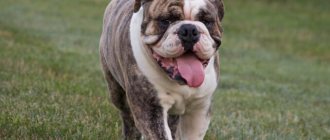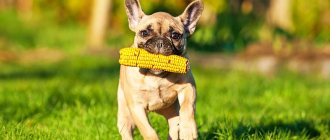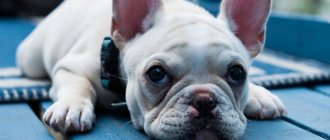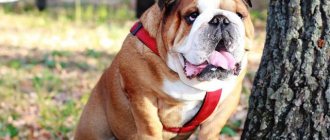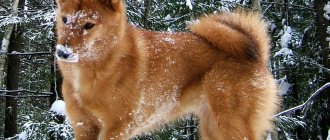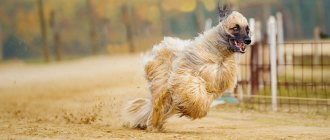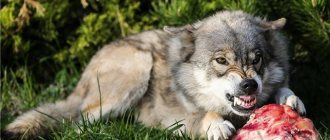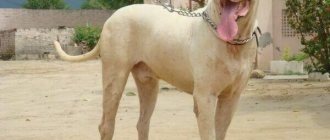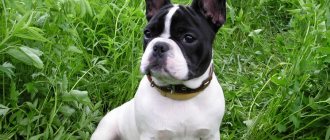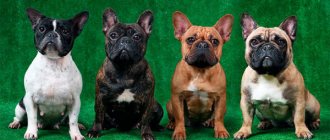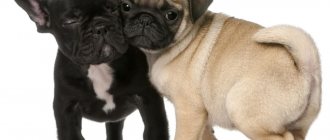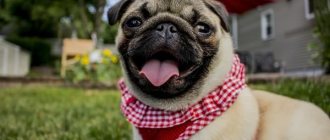Origin
The origin of this variety of bulldog is attributed to Pakistan, which is not far from the truth. The first mentions of gul dong at the end of the 19th century referred to the territory of this country. However, technically, the territory of modern Pakistan was considered an Indian colony, which means it makes sense to say that the origin of the dog has Indian roots.
It is difficult to find out the exact history of the origin and selection of fighting bulldogs due to the narrowness of their distribution area. Gul dong can be found in Pakistan, India, Iraq and Afghanistan. The ancestors of the Gul Dong are considered to be the Pakistani Mastiff (Bully Kuta) and the Pakistani Fighting Terrier (Gul Terrier). A number of sources mention the Dogo Argentino, the Old English Bulldog and the Bull Terrier. The selection principle was characterized by four main cherished qualities: power, speed, agility and aggressiveness. The breed has not received recognition from cynological associations around the world.
By
Education and training
It is extremely difficult to earn the authority of this proud and courageous dog. She will submit only to a physically and morally strong person who has more than 1 year of experience with fighting dogs. She needs to demonstrate her authority as early as possible.
Taking into account that Gul Dong is an extremely dangerous dog, it is often necessary to train him using physical force. No, we are not talking about a merciless beating. But sometimes, in order to show an animal its place in the house, it is necessary to take measures that are not entirely humane, as it seems at first glance. Until the baby gul dong grows up, train him.
With proper training, Gul Dongs grow up to be loyal and discreet dogs.
Learn the simplest commands and demand their execution. It doesn't hurt to be persistent here. If he resists, turn him over on his back and hold him for a minute, ignore pleas to break free. Release your dog only after he has completely calmed down. This is a simple exercise aimed at subordinating her to her human master.
We recommend reading: Brazilian Bulldog (Campeiro) - description of the breed
Never encourage empty displays of aggression in your pet. He should not get angry at every occasion, especially expressing antipathy to his household. If this happens, turn him onto his back again and hold him. Always lock such a dog in an enclosure if you have guests over. She must not contact them. Always wear a muzzle when walking.
History of the breed
It is impossible to calculate how many dog breeds there are in the world. Experts talk about more than 400 officially registered species. There is a special group of animals that remains outside the classification of cynologists. These are aboriginal dogs - the most ancient inhabitants of the planet among their relatives, who have an incredibly strong genetic memory from their wild ancestors. These include the Pakistani bulldog, or mastiff - gul dong.
Gul dong
The breed was developed in the 19th century in Pakistan, which was then part of colonial India. The “parents” were the Bully Kutta (Pakistani mastiff) and the Ghoul Terrier, which is similar in appearance to the English Bull Terrier and Dogo Brasil. The latter came to Pakistan during the time of British expansion into India.
In an economically backward country, crude selection was practiced in artisanal conditions. Weak cubs died, the strongest had the right to life. Two centuries ago, Pakistanis did not care about the socialization and legal integration of dogs into society. There were no nurseries for breeding the breed, as there still are none, so it is impossible to trace the pedigree.
Gul dong with the owner
The result of crossing the bloodthirsty bully cutta and the brave ghoul terrier was a beautiful, strong breed - the dog fighting gladiator gul dong. In the arenas that still exist underground in Pakistan, the opponents of the gul dongs were wild predators (bears, wolves), bulls and dogs of other breeds. No one stood a chance against the fearless fighter.
Note! The owners made a lot of money, purebred puppies were expensive. Only a very rich person could afford to buy an adult.
How to distinguish Gul Dongs from similar breeds
Ghoul Dongs are very difficult to distinguish from Dogo Argentinos, they will have approximately 80% of the same appearance and character (due to common ancestors). The main difference between Argentinean and Pakistani bulldogs is the size of the limbs. In the former they are denser and shorter.
In the photo, the Dogo Argentino, which is distinguished from the Pakistani bulldog by stronger but shorter limbs and a smaller tail
The Pakistani bulldog is practically indistinguishable in appearance from the Gul-Terra and Billy Kut. The main criterion that allows a dog to be classified as a gul dong is a stronger grip and an evil character. No one accurately measured the power of jaw compression (no canine examination was carried out, since no federation officially recognized the breed). But judging by the results of underground dog fights, gul dongs easily cope with their “ancestors”.
In the photo there is a Billy Coot puppy, but small Pakistani bulldogs look the same, there are no characteristic external differences - the only difference is in character (Billy Coots are less aggressive and obey their owners better)
Dimensions, appearance
Cynological associations do not recognize the existence of such a breed as the guldog. Therefore, there is no point in talking about breed standards. The selection of individuals for mating is carried out according to the same four parameters: power, speed, agility, aggressiveness.
An adult male reaches 70-80 cm at the withers, a female's height is 60-70 cm. The tallest recorded height of a ghoul dog is 116 cm. The weight of an adult dog ranges from 35 to 60 kg. Sources call the specimen weighing more than 95 kg the most massive dog of the breed. The body structure of females and males does not differ significantly.
Body structure
The body is proportional with pronounced muscles.
Powerful long neck, large head, sometimes seeming disproportionately large in relation to the body.
The Pakistani has a long tail, which is docked for puppies intended for fighting. Even the undocked tail of the Gul Dong does not rise high.
The coat is short and harsh. The color is varied (white, black, red, gray, solid, with stripes or spots). The most popular dogs are those with light coats. The short, hard coat lies closely to the skin.
The paws are long, powerful, without curvature.
Muzzle
Broad forehead. The transition from the forehead to the muzzle is small and weakly expressed. The mouth has folds of skin. Ears are floppy from birth. Most representatives of the breed have their ears cropped during puppyhood. Cropped ears stand upright.
The almond-shaped dark eyes are distinguished by a wide set on a short muzzle with a rounded nose, often fully pigmented or in small spots.
The jaw muscles are highly developed. The jaw bones are powerful, massive with large, strong fangs. When closed, they form a correct scissor grip.
Mating
To get offspring, you will have to mate ghoul dogs. Before you start knitting, you need to familiarize yourself with the basic rules for this procedure:
- for mating, you need to choose dogs that have already completed puberty;
- Before mating, animals must be walked for 4-5 hours;
- Mating should be done no later than 12-15 days after the start of estrus;
- a month before mating, animals must be treated for parasites.
Bull Terrier - a child of a harsh era
There are many legends around dogs of this breed, which was bred in England in the mid-19th century, the reason for which was the aggressiveness of the dogs.
The negative attitude towards the breed among the population was formed, first of all, thanks to newspaper reports and news releases. But in fact, in the past there are times when some representatives of bull terriers took part in dog fights, tearing up hundreds of rats for the amusement of the public.
The modern representative of this once fighting breed is a good protector and a reliable bodyguard. The main thing is to raise him correctly.
For future owners
Fighting dog breeds are becoming more popular, but before choosing such a puppy, it is better to immediately determine the rules of treatment and quality criteria so that the dog respects you, listens and follows commands
You will have to put in a lot of effort, but training and attention will allow you to raise a smart pet even from a small fighting dog
Immediately determine which breeds of dogs are classified as fighting dogs, because these are the ones that can or participate in dog fights.
We are talking not only about those who are already doing this, but also about those for whom the battle is genetically based, they have certain character traits and body structure.
The basic rules of behavior with these pets are:
- immediately decide whether the dog will participate in battles or not;
- in case of possible battles, you will have to devote time to training and training;
- start with basic commands: bring, face, sit;
- for training you can use large tree sticks, rubber tires and special toys;
- It’s better to get additional advice from a dog handler who will give recommendations based on the breed and purpose of your dog;
- you must immediately show that you are the master and you will have to be obeyed strictly.
There are rules for the behavior of fighting dogs when walking and in contact with other animals:
- It is better to walk the dog in a muzzle and on a short leash;
- If clashes with other animals occur, you must immediately take the dog by the collar and take it aside. But petting the head and giving treats is not worth it, the dog may bite you;
- in case of skirmishes, you need to pull the dog away by the tail and lower part of the body;
- You shouldn't hit dogs;
- Do not give your puppy's personal toy to another dog, otherwise it will provoke a fight.
To prevent such situations from arising at all, you need to devote at least an hour and a half to training your pet every day. It is better to do this in an open area, but without strangers or other animals. Respect the dog, do not hit it and reward it for following commands.
Character traits
The Pakistani bulldog is distinguished not only by its intelligence, cunning, stubbornness, but also by its devotion to its owner and his family. This fact does not diminish the danger of the breed to others. Gul dogs are dominant dogs with increased aggressiveness that require specific training by an experienced dog handler.
As soon as the owner of the Pakistani dog gives up the dominant position of the “leader of the pack” a little, the dog will not hesitate to show aggression and attack the “weakened leader.” The appearance of a stranger on the territory of the gul dong, noise, bustle, other animals and any other irritants will provoke an immediate attack.
Pakistanis are not adapted to urban conditions and living in an apartment. Temperamental dogs are constantly looking for a point of application of boiling energy, because, deprived of fighting practices, they remain excellent watchmen and security guards. Gul dong is suitable for keeping in an enclosure in a village or small settlement with a large local area. In any case, representatives of the breed need to exercise a lot during the day. Walking a gul donga is not a leisurely walk, but a jog at a good pace or a bicycle cross.
Pros and cons of the breed
Despite many negative reviews and characteristics, gul dong, with proper upbringing and treatment, can become a faithful partner and an excellent guard for a strong man.
The Gul Dong, like any other breed, has not only disadvantages, but also advantages. The main pros and cons are outlined below.
Advantages:
1. Ideal security and guard qualities. 2. Innate hunting instinct. 3. Easy care. 4. Intelligence and intelligence. 5. Strength, endurance.
English Mastiff: the largest on earth
This is the largest dog breed on the planet. Their ancestors made a glorious fighting career. Clad in armor, they fought in the war dog squads of the armies of Alexander the Great and Julius Caesar, and fought to the death in gladiator fights. It is believed that they originate from Tibetan mastiffs. These giant dogs need a steady hand. The owner’s job is to educate and train. Mastiffs are easy to train. They make excellent bodyguards, companions, and watchmen. These kind dogs treat their owners with love, are obedient and flexible, and will never bark for no reason.
Ca de Bou
Mention of Ca de Bou was found on bas-reliefs of the 17th-18th centuries, almost the oldest arena in Mallorca, which still knew bull baiting. Incredible endurance, damn agility, tough grip - all these qualities are fully inherent in Malorsky bulldogs. Without them, they would not be able to resist angry bulls, other dogs would not be able to do so.
Unquestioning obedience to man was always required from this dog. Now they are devoted bodyguards, irreplaceable watchmen.
They are obedient, peaceful and unobtrusive around their owner. These are smart dogs with a strong psyche, very capable and easy to train.
And Ca de Beau will not bark over trifles, but will patiently wait for the owner to pay attention to him
Training
Two important points of training are dominance and socialization. Gul Dong puppies raised in isolation from people and other animals are as aggressive as possible. Socialization should begin at a very early age and continue throughout the dog's life.
Wayward Pakistanis occupy dominant positions in the dog hierarchy. This must be taken into account by the owner, who will have to train himself, because the owner must literally suppress the will of the dog.
A beginner in the field of cynology and training risks his life and health by acquiring a representative of the gul dongs. The most insignificant nuance in relations with an animal or the slightest indulgence can cause a loss of authority in the eyes of a Pakistani and provoke an instant attack.
For example, when walking, a Pakistani bulldog should always be at least one step behind its owner. From puppyhood, the dog must be constantly monitored and in contact with it, in order to avoid the same loss of authority.
By
What is the character of gul dongs?
Even a trained dog will still be aggressive. She seems to be in constant tension and perceives everyone around her as potential enemies. It will never completely obey its owner - as soon as the dog feels that the person is losing control over it, an attack can be expected at any moment.
Even at home you need to keep your gul dong on a leash and only take it out in public wearing a muzzle.
The owner’s task is to always be ready to repel the attack of an angry dog. Leaving a dog alone without control with other people (whom the animal does not consider as owners), and especially with children, is deadly for the latter. Gul Dong takes all animals (even his fellow tribesmen) with hostility and seeks to attack.
There is a huge risk in letting children approach the gul dong like this - the dog can tear the kids apart in a couple of minutes
Is the dog trainable?
A person manages to train tigers and bears, of course, he can train a gul dong. But this should be done by those who are professionals in matters of training. If you have never had experience with fighting animals, then getting a Pakistani Bulldog right away is dangerous, as it is one of the most uncontrollable and aggressive dogs.
When raising this dog, you cannot make concessions or show weakness. This can result in complete disobedience of the gul dong and, as a result, end in tragedy for the person.
The dog is definitely not suitable for keeping in a house or apartment. She needs to be kept in an enclosure in the yard, separately from other dogs (otherwise the strongest will tear the weakest apart, as soon as the owner turns away). You need to exercise your dog every day. Training should be aimed at instilling unquestioning obedience. For example, during a walk, the dog should always be one step behind the owner, not next to or in front. Thus, a social hierarchy is formed, the dog understands that the person is in charge.
Gul dongs are smart, they understand commands well, but due to their stubbornness and mistrust they are reluctant to carry out human orders
The Ghoul Dong needs to be socialized from puppyhood. If the dog is completely isolated, then his level of aggression will be maximum. The animal must constantly see people, although it is not at all necessary for strangers to touch the dog. Proper upbringing and socialization can reduce the level of natural aggressiveness and make the dog more obedient (although it will still not stop being dangerous, the owner must constantly remember this).
Alano Espanyol: a dog with roots from antiquity
The Book of the Hunt (1311-1350) contains the first mention of Spanish bulldogs. Simultaneously with the Alan tribes that invaded the Pirnaia in the 4th century, dogs with a short, wrinkled muzzle arrived here. They became extremely in demand in pacifying restive bulls participating in bullfights, in protecting their master's property, and even hunting Indians. Later, by the end of the 19th century, with the ban on the participation of dogs in “pacification”, Alanos were not so popular. And already by 1939. it was believed that the breed had completely disappeared.
Photos and videos
In the photographs presented in the gallery you can see what dogs of the Gul Dong breed look like. The pictures show Pakistani bulldogs of different genders, ages and colors.
Maintenance and care
Gul dongs are unpretentious in maintenance and require only a minimum of sanitary procedures. It is necessary to wash the dog completely no more than 1-2 times a year. Short hair does not need a hair dryer; exposure to a stream of warm air can even cause drying of the skin.
Grooming involves combing with a thick rubberized glove in the direction of hair growth up to 2 times a week.
Cleaning the eyes with a cotton pad soaked in warm water is done as needed.
Once a week it is necessary to treat the ears of a Pakistani bulldog with a cotton pad soaked in hydrogen peroxide.
Claws should be trimmed with special pliers once every two weeks to a month.
Cleaning with a special fingertip and toothpaste every 3 days will help prevent problems with teeth and the appearance of plaque.
Optimal conditions for keeping a Pakistani mastiff
The Pakistani Mastiff is a very large and aggressive dog that is not suitable for apartment living. It will grow and develop most favorably in a country house in a spacious enclosure. The dog should have its own private place. It can be built from an ordinary old mattress. The dog can quietly bask in the sun all day, and become active in the evening. Your pet needs at least two hours of daily active walks. It is best to choose deserted forests and fields for this. When walking on a leash, the owner should walk forward and the dog should follow him. This way you demonstrate your leadership position.
The Bully Cutta is a short-haired dog breed that does not require much grooming. So, in order for your pet to look neat and well-groomed, it is enough to comb its fur once a week with a special brush. There is no need to wash your dog. It is enough to wipe the wool with a damp cloth a couple of times a month.
Particular attention should be paid to the face and chest, where the pet's saliva can get in. Ear and eye cleaning and nail trimming are optional procedures.
Education and training
The Bully Cutta is not a dog for amateurs or beginners. Raising and training her requires a professional approach and skills. To raise an easy-going and loyal pet, it is necessary to start training from an early age. The main thing in the training process is to show who the leader is and not show your weakness, since the dog prefers to dominate rather than obey. Despite the fact that the dog has high intelligence, it does not always follow the owner’s commands. And this is primarily due to her stubbornness. It is necessary to start training with simple commands, gradually moving on to more complex ones.
Assault should be excluded from the process of education and training. The owner needs to find verbal and visual contact with his pupil.
Assault is strictly contraindicated in the process of education and training.
What and how best to feed a fighting dog
Not every breeder can afford to feed such a huge animal, so before getting a Bully Cutta pet, you need to carefully weigh the pros and cons. After all, your pet’s daily diet should consist of protein foods:
- meat;
- sea fish;
- cottage cheese;
- eggs
In addition to natural food, the pet should receive a whole range of vitamin and mineral supplements.
As a rule, you should feed your dog only once a day, but it is not always possible to maintain such an interval, so experts allow feeding twice a day: in the morning and in the evening after a walk. A dog needs a lot of liquid, which means you should always make sure there is clean water in your pet’s bowl.
Protein food is the basis of the bulli kutta diet
Characteristic
- Fighting, hunting dog.
- Height ranges from 65 centimeters to 100.
- Weight from 50 to 60 kilograms.
- The coat is short.
- Color varies; black, gray, brown, often with white or black stripes or specks. The most common color is white with various inclusions.
- The head is large and massive.
- Wide forehead, short muzzle.
- Large skeleton with a deep chest and a long, tapering tail.
- Large massive paws.
- Small dark eyes.
- Drop ears, sometimes cropped.
Nutrition
Keeping a Gul Dong dog is not cheap. The powerful muscular frame of the Pakistani needs constant replenishment with protein. When purchasing a dog, you need to make a choice in favor of natural food or dry food, and not mix these food lines in the future.
Natural food
The Pakistani Bulldog eats about 3 kg of meat during the day. The basis of the diet is:
- Lean meat and fish;
- Giblets;
- Broths based on meat and fish, soups based on them;
- Porridge to provide the body with fiber;
- Fermented milk products: cottage cheese, kefir, yogurt;
- Fresh vegetables to maintain vitamin balance.
Dogs are prohibited:
- Fat meat;
- Bones;
- Bread products;
- Legumes, corn, onions, potatoes;
- Sweet, salty, sour, bitter, pickled, fried, smoked food.
Dry food
Dry food should satisfy the Pakistani Bulldog's body's need for proteins and vitamins. Gul dong needs a quality product. The daily amount of food should be selected based on the needs and age of the dog, as well as the composition of the food.
Regardless of the type of food, a Pakistani needs constant access to plenty of drinking water and periodic use of vitamin complexes.
Diet for an adult dog (from six months): 1-2 times a day. Malnutrition is most pronounced in the lower ribs. If the lower costal arches begin to bulge, the dog needs to increase the amount of food.
What to feed?
Here you have two options to choose from: feed homemade food or use balanced ready-made food. You should not combine both of these options in order to avoid health problems.
Up to a year old, a puppy should be fed up to six times a day in small portions. If we consider in more detail, then this number of meals should be adhered to for up to four months; then until six months you need to feed four times a day, and from six months to a year - three times. This will ensure that the baby’s growing body develops the correct bone structure, muscle and fat mass.
After a year, you need to switch the dog to two meals or one meal a day, but with an increase in portions. In order for the skeleton to develop well, it is necessary to include foods that contain calcium in the diet. These include kefir and cottage cheese.
Vegetables must be boiled or scalded with boiling water. After cooling, mix them with oatmeal, buckwheat or corn porridge and add vegetable oil.
For a balanced diet, the main ingredient is lean meat or meat by-products. The latter should be given only to adults who can easily chew them well. It is better to use chicken, beef, veal or rabbit meat. Turkey would work too.
Best articles: Red or red lynx
There is no need to cook it - just pour boiling water over it or give it straight raw. You shouldn't get carried away with fish. You can indulge in it very rarely, to saturate it with vitamins and amino acids. Fish bones should be selected carefully. Any others can be given without fear. Eggs should also be included in the diet.
When choosing ready-made food for your dog, do not skimp and feed with premium food. Cheap ones are not suitable for this breed. In any case, whatever food you choose, you need to supplement it with special vitamins, which your veterinarian will help you choose. You also need to constantly ensure that the dog has a sufficient amount of water and that it is freely available.
This is especially true for dogs that eat dry food. Swelling in the stomach, they take all the liquid there, which is why the pet will need constant replenishment.
When balancing your pet’s diet, it’s worth considering that you need to completely exclude the following foods:
- sugar;
- salt;
- seasonings and spices;
- milk;
- fatty meats (pork, lamb);
- legumes;
- bread, baked goods;
- potato;
- candies, cookies.
When training, as a “carrot”, you can reward him with cheese or crackers, prepared independently without any spices.
For an overview of fighting dogs of Pakistan, see below.
Health
Due to its vicious nature, this breed is often used as a fighting dog. Then her ears and tail are cropped. Due to heavy physical exertion, such animals do not live longer than 7 years.
If the dog lives on the street, you should carefully ensure that the box is dry, with tightly fitted boards. They do not tolerate drafts well. Most often this ends in otitis media for them. Accustomed to high temperatures. But frosty winters are bad for them due to their short fur.
Very rarely they have genetic abnormalities. Anomalies in skeletal development are associated with a poorly selected diet and lack of nutrients.
The problem for these dogs is the appearance of tartar and unpleasant odor from the mouth. To avoid this, teach your puppy to brush his teeth once every two to three days from the age of two months. Then, having matured, he will perceive this procedure calmly. In addition, toys are needed that will help get rid of tartar.
Interaction with others
If you have a large family with children, you should not get a puppy of this breed. Gul dongs are too possessive to share their place, toys and bowl with someone. Children are jealous of their owner
, may bite or attack. This applies not only to children, but also to teenagers.
They behave appropriately when animals lived in the house before. The dog more easily perceives the presence of rivals, marking the territory, but trying to make friends with them.
Reacts poorly to strangers
. Therefore, when going out for a walk, do not forget about a muzzle and a leash, for those who live in the city. This breed is not suitable for older, physically weak people. But it will be an excellent companion for an adult man with good physical fitness.
Breeding and cost
As was written above, dog handlers do not recognize the Gul Dong breed, therefore, it is impossible to get a puppy or an adult dog in an official kennel, since such establishments, registered in full form, simply do not exist in nature. This is not a surprising fact, given that in many countries the breeding of such fighting dogs is prohibited.
Breed standards and breeding of dogs are carried out in their historical homeland - Pakistan and India. Distinguishing a Pakistani puppy from a Dogo Argentino or Bully Cutt puppy is a task for a professional. As a rule, when making such a choice, reference is made to the structure of the paws and the power of the bite.
Gul Dong puppies are sold much cheaper than adults. A small representative of the breed will cost from 5 to 11 thousand rubles. An adult, trained and trained dog will cost at least 35 thousand rubles, which is an impressive amount in Pakistan.
General information
The Pakistani Bulldog is not suitable for the role of a companion; it is intended for hunting, guarding or guard duty. Of course, there are few of these dogs around the world for the reason that most people are simply afraid to have them. They can be dangerous not only for strangers, but even for the owner himself.
History of Pakistanis
As the name suggests, these dogs originated in Pakistan. Presumably, their ancestors are English dogs and Dogo Argentino. While breeders were working on the breed, these dogs were crossed with various powerful breeds. The goal of the specialists' work was to obtain a huge, powerful, aggressive, fearless, fast fighting dog. The result of successful work was dogs of the Gul Dong breed. They make the best gladiator fighters, receiving speed and strength from their ancestors.
People who owned dogs of this breed used them to fight large predatory animals or dogs. At the same time, they won considerable sums of money for victories. In addition, with the help of these dogs, the house was always protected, and you can also hunt big game with them.
The cost of a purebred representative is quite high. People could still afford to buy a gul dong puppy, but an adult dog that participated in battles and won there could only be bought for a lot of money. Only wealthy people could afford it.
Description of the breed
To date, this dog breed has not been recognized by any cynological association. Therefore, there is no official standard for it either, just as there is not a single official nursery breeding this breed.
Of course, there are breeders in Pakistan who breed Ghoul Dongs. They also have a breed standard.
Representatives of the Gul Dong breed are very similar in appearance to Dogo Argentino. They are very similar to each other, not only in appearance, but also in character. However, they differ in the size of their paws. In Pakistani Bulldogs they are thinner and longer.
The appearance of Pakistanis is very similar to the Bully Kutta breed. In appearance, it is almost impossible to distinguish them, however, the gul dong is more aggressive and has a more powerful jaw grip.
The dimensions of Pakistani bulldogs are as follows: height at the withers is from 78 to 116 cm, their body weight can be from 68 to 97 kg.
They have a huge head, which immediately catches the eye, and a powerful, long neck. These dogs have drooping ears, but they are cropped so that during fights the enemy cannot grab them. They have dark, small, almond-shaped eyes. Medium sized black nose. The tail of the gul dong is long and thin, hanging low. The tail also needs to be docked if the dog will participate in fighting. The paws of these dogs are muscular, long and smooth.
Pakistani Bulldogs have a short and coarse coat. Its color is most often white with various markings of grey, brown or black. Such pets are more valuable. In addition to them, there are also representatives of this breed of gray, brown, black or brindle color.
Learning ability
Gul-dong is a difficult animal to train. For good adaptation and if you want to have him in a city apartment, you need to train him from a young age. Only a few people get such a dog; not all experienced dog handlers agree to have a time bomb at their side. In order for the class to go perfectly, it is worth letting the puppy know who is in charge. Otherwise, he will become not a companion and subordinate, but a willful master of the house. Everyone at home will have to adapt to his mood.
When training him, it is necessary to conduct such classes every day and throughout his life. Then the acquired gul-dong knowledge will be easy to put into practice.
Breeders complain that neglected dogs can only occasionally follow orders, reacting most to commands: “Fu,” “stranger,” “guard.”
Dog training and training
French bulldog (black and blue): description of the breed
Subduing an animal and raising it is not a task for every dog breeder. Puppies are trained from birth. They naturally intend to dominate the world. A newcomer to the task of taming a Pakistani risks his health and even his life. Experienced dog handlers work with animals.
Gul Dog is a dog that from the first day must understand who is boss in the house, accept his authority and strictly obey. This is possible if a person with a strong will literally suppresses the dog.
Training has two goals - to show the dog that the person is more important and to adapt the dog, as far as possible, to society. A puppy who does not see people or other animals from birth grows up to be an aggressor. Results in training are achieved by constant control and encouragement of the animal.
Summing up
Dogs of the Ghoul Dog breed are aggressive, cunning and intelligent. For an owner who has managed to properly socialize and raise a Pakistani dog, and is also able to constantly maintain his authority as the “leader of the pack,” a powerful dog will become an excellent watchman and protector.
However, in the hands of an inexperienced dog breeder, a Pakistani bulldog will be dangerous not only for surrounding animals and household members, but also for the owner himself. Before choosing a pet of this breed, you should soberly assess all the risks of owning a difficult-to-train dominant fighting dog.
Views: 617
Life expectancy, major diseases and vaccinations
Cataracts are a common disease in dogs.
The life expectancy of this breed is 10-12 years. However, with the development of diseases, such dogs live much shorter. Common diseases include the following:
- conjunctivitis;
- cataract;
- glaucoma;
- demodicosis;
- osteosarcoma;
- hypothyroidism;
- bloating.
To protect your pet from many diseases, vaccination is carried out. Vaccinations should be done annually to strengthen the immune system.
Dogue de Bordeaux: a dog with an iron grip
Only by the 19th century in France did this breed, bred earlier, gain real popularity. Dogs became participants in gladiator fights, hunting large animals, baiting animals, even wars started by great rulers.
And today Great Danes have to fight dogs of other fighting breeds, albeit in illegal fights. One can only be glad that they are more often found in families that love them, and that the manifestation of fighting skills from them may be required only when there is a real threat to one of the members of the family in which they live.
The Great Dane is quite zealous about his duty to protect the house. Dog quarrels are not for him. In addition, the Dogue de Bordeaux is a vulnerable and very touchy creature that does not tolerate shouts and unreasonable punishments. The owner will have to pay attention to his bulky pet.
Lack of attention and encouragement of malicious attacks will lead to the fact that instead of a reliable friend, an aggressive dog will be nearby.
Choosing a puppy
You need to buy ghoul dog puppies - they are the best to train.
Choosing a puppy on your own is not easy. However, there are several recommendations that will help you choose and buy a dog:
- You need to buy a puppy from a nursery that specializes in this particular breed;
- before purchasing, you need to evaluate the puppy’s parents and make sure that they are not sick;
- puppies should be carefully examined and checked for moles;
- you need to observe the behavior of the dogs and make sure that they get along well with other animals.
Bully kutta
This is another name for this breed. The combination of words comes from Hindi and translated means “wrinkled dog.” There are several other variants of the name - Singh Mastiff, Indian or Alang Mastiff.
This breed most likely originated from the aboriginal dogs of southern India, which were used as guard dogs. During the colonization of the Indo-Pakistani territory, the British crossed it with the imported English mastiffs and bull terriers to enhance its fighting qualities.
From ancient sources we know that dogs similar to the one described were seen back in the 5th century BC in Greece, when the army of the Persian king Xerxes the First passed through the country. Fierce dogs of enormous stature guarded food and other convoys. It is also known that Pakistani mastiffs were kept by Indian royal families for games and hunting, however, later their use was reduced to guard duty.
Possible diseases and methods of treating them
Only those animals whose natural defenses have been weakened during evolution are prone to frequent diseases. Gul dong is not one of them; on the contrary, he is very hardy and healthy. This dog tolerates sudden changes in weather, viral infections and even colds well.
However, he may develop dysplasia or cataracts. In each of these cases, he requires the help of a veterinarian. An owner who cares for his faithful four-legged friend must give him medication for parasites, especially fleas, every year.
Is it possible to keep in an apartment?
Bully Kutta is not recommended to be kept in an apartment. This is directly related to the fact that dogs are active and require regular exercise. They require a lot of space for themselves, as they love easy walks within a spacious room.
Important! If you keep the Bully Cutta on a leash for a long time, he will become an aggressive and unfriendly dog.
In their homeland, Bully Kutta often live in yards and very often remain on a leash. However, this use of the animal is not entirely correct, since it is freedom-loving, although it is attached to one territory of residence.
Interesting Facts
There are several interesting facts about gul dogs:
- this breed is considered one of the largest;
- some dogs can grow up to 120 cm in height;
- Previously, people believed that such giant dogs were able to ward off evil spirits.
The Gul Dog is a fairly common breed in Russia and abroad, which is often used for hunting and protecting territories. Before you get such a dog, you need to familiarize yourself with the whole truth about this breed and how to keep such dogs at home.
